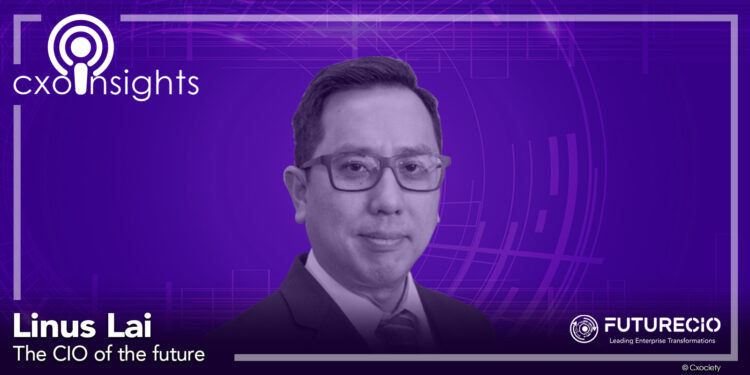According to a study by International Data Corporation (IDC) by 2026, 40% of enterprise revenues in Asia will be generated from digital products services, and experiences. A digital business uses a business-led approach to value creation based on the use of digital technologies. Today’s enterprises have been dipping their toes in digital technology. Around 70% of enterprises said that they are very interested in and are willing to use it in either operations or business models.
“It is not about creating a digital strategy for our business, but about creating a business strategy for our digital work,” quoting Lidia Fonseca, the digital chief technology officer of Pfizer, Linus Lai, vice president for digital business and trust, Asia/Pacific at IDC talked about digital and sustainable business models, especially in the age of digital transformation.
Digital and sustainable business models
Linus Lai: We have had several categories in the Future Enterprise Awards, ranging from the future of work to the future of operations to the future of customers, to the future of digital infrastructure, and so on.
The maturity shows how organisations now move away from siloed innovation in specific business units and projects into changes that could impact business and operating models. As a result, we saw organisations change the organisational model as well.
We are using the C-suite study that we ran. It is our research on executives and digital leaders. On average, enterprises acquire about 47% of their revenues from digital product services and experiences.
Impact on IT
Linus Lai: Our research from the C-suite tech survey of over 200 executives reveals that most of the digital initiatives today are owned, not by IT, but by the C-suite line of business or jointly owned by the C-suite line of business and IT or orchestrated by the C-suite team.
IT ownership, in terms of project execution, is now at 41%. C-suite execution is now at 59% across the region. It is a healthy indication of the maturity of how businesses run transformation and execute digital strategy. That is why it has become a business and an operating model priority.

They are focusing now on operational excellence and strategy execution, not just on the digital side.
We are in a good position now. IT leaders understand and know that they are also elevated as a result. Now they are elevated to be a business transformation enabler instead of just running IT or taking care of the data center.
Linus Lai
On average, CISOs are now talking to their boss a lot more often. They often stand in front of their boss once a month to give some reporting and just some education as well as some business cases for some investment as they digitise more, because, as you do that, your risk also increases, like customer data, privacy, and 3rd party supply chain rates, et cetera.
Impact on CISO
Linus Lai: The pandemic drove everyone to do it remotely. We saw a lot of new technologies that enable agile teams to get together. Now because of these changes, the scale in which revenues are now derived from digital products, services, and experiences organisations know that agile methodologies are here to stay and extremely important. That is why security now plays an important role as they start to shift left.
Instead of being only involved at the end when the team checks the application over the fence to them for review, they are much more involved upfront now. While the business is interested in generative AI, automation, cybersecurity, and local nuclear technologies, CIOs are still the custodians of the platforms and the architecture to support the business. Now they are still very much focused on cloud operations, cybersecurity compliance, infrastructure and software services, data analysis, management, co-creation, and DevOps to get that agility.
Best collaboration practices
Linus Lai: There are two spectrums and there is no right answer. On one side is the business team that is very used to checking requirements over to IT. There are priorities and governance.
And then you have teams that are perhaps a lot more mature, they orchestrated across joint ownership and function and it's a ton of value. The business brings with it its knowledge and understanding of what needs to be transformed.
From an operating model perspective, the CFO is leading a finance transformation. It is about modernising the way revenue assurance is done, it is about looking at text and compliance differently and it is about transforming risks as well. The CFO then pairs with the CIO to drive the outcomes.
From the CIO perspective, the design principles of the platform, being cloud, native, trusted, agile, modular, intelligent, et cetera is what they bring to the table. They are also very good with agile methodologies and frameworks.
The CFO brings that finance transformation, toolkit, and experience to drive changes within the finance organisation to such an extent that they can choose the vendor and even the services provider. Based on our data, we are starting to see organisations migrate more as they increase in maturity.
Impact on budgeting from an IT perspective and accountability
Linus Lai: IDC research does point out that from a spending perspective from our spending guides, you will see the balance shift towards the business. This year I focused on not just the spending, but how the digital initiatives are managed.
If you are doing these types of business transformation, whether you are building a supply chain control tower, the business has to be responsible for these use cases to be adopted. IT is also responsible for the platform components, the infrastructure, and the application operations integration That is needed. Most applications do not stand alone. A lot of external data from the ecosystem is now needed to drive digital business outcomes.
If you are thinking about integrating data, it is not internal data that you have to think about anymore. It is about data from your external ecosystem partners. A lot of integration needs to happen; that is the domain of IT. Businesses rely on it for the application development stack, but the business is the one that is driving the outcomes, whether it is revenue outcomes or risk outcomes.
Click on the player as Lai talks about the cheat codes for a digital and sustainable business:
1. How do digital products and services impact business models?
2. What are the impacts of digital business models on IT teams and CISOs?
3. What are the best collaboration practices in terms of handling digital business models?
.4. What are its impacts on budgeting from an IT perspective and accountability?
5. How is the role of the CIO evolving?





